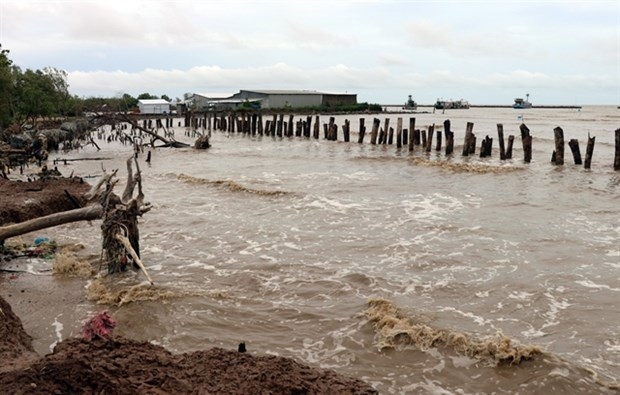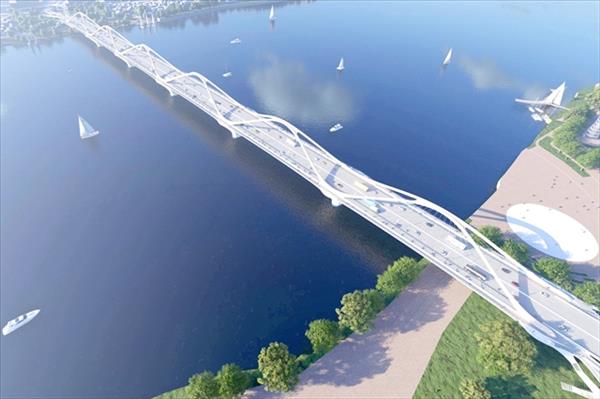Over the years, Ninh Binh has aggressively implemented measures to conserve biodiversity and sustainably develop the value that natural ecosystems offer.
Van Long Wetland Nature Reserve, Ninh Binh's Gia Vien district, is a complete residual wetland in the Red River Delta region, comprised of rivers, shallow lakes, and vegetation with distinct ecological characteristics, resulting in a distinctive natural landscape.
Van Long also has high biodiversity value, including two ecosystems, the wetland environment and the limestone ecosystem.
More than 720 species of plants from 277 families and six phyla of higher vascular plants can be found in the area, with many included in the Vietnam's Red Data Book.
The range of animals is also incredible. There are 39 species of mammals, 100 bird species, 38 reptile and amphibian species, 43 fish species, 132 insect species, 48 terrestrial mollusc species, and 60 aquatic mollusc species all recorded here.
Notably, Van Long Wetland Nature Reserve homes the greatest number of langurs in Vietnam that could be witnessed in the wild.
The location holds two Vietnamese records: "The conservation area with the biggest langur population in Vietnam" and "The region with the largest natural scene in Vietnam".
Bui Cong Chinh, head of the Hoa Lu-Gia Vien Inter-district Forest Protection Department, stated that sustainable forest management is crucial for identifying basic measures in sustainable forest resource management, attracting investment in developing eco-tourism, creating jobs for locals, and improving the lives of people in the region.
The department has organized patrols to protect forests, and teams to prevent and control forest fires over the years to conserve biodiversity and forest resources. Patrol routes have been built, particularly in key zones and locations with rare and precious species of flora and fauna, to prevent illegal exploitation, trading, transportation, storage, and processing of forest products.
The department also arranged for staff to visit, gain practical experience in law enforcement, and increase their knowledge of the environment, land management, and use of sustainable resources.
They have worked with related agencies to finish the reserve's biodiversity project and unified management of the entire forest land and wetland area. In addition, they have also worked out plans for sustainable management of special-use forests and a management programme for tourism industry in reserve to protect its integrity.
The Trang An landscape complex is located in the area of Hoa Lu special-use forest, with a high level of biodiversity and two major ecosystem types: a limestone and an aquatic ecosystem.
Biodiversity in Trang An is evident in the diversity of species composition and genetic resources and the presence of numerous endemic and uncommon animal and plant species.
There are currently 134 plant families, 384 genera, and 577 species described in the flora of Trang An. In particular, there are 10 species listed in Vietnam's Red Data Book that need to be conserved and seven species that have never been seen before in the country's flora.
Trang An complex's fauna is also exceptionally diverse, with 30 species of zooplankton and 40 species of benthic creatures living in the marsh. The striped-necked turtle, which can only be found in Trang An, is an endangered species that must be protected.
Notably, after being relocated by Cuc Phuong National Park and the Vietnam Wildlife Conservation Centre to the Ngoc Island region of Trang An complex for more than a year, a langur family has produced its first offspring.
In the near future, the Management Board of the Trang An Landscape Complex intends to breed several endemic and rare species for raising, additional planting, reducing the risk of extinction, and locate suitable sites to establish an artificial habitat and preserve some of these species for biodiversity in the near future.
In 2004, UNESCO identified seven coastal communes within the administrative boundaries of Kim Son district in Ninh Binh, in the buffer and transition zones of the Red River Delta Biosphere Reserve.
These locations are currently sustaining great biodiversity values with rare species of worldwide significance and many rare species documented in the Red Book of Vietnam and the world.
For a green Ninh Binh
Ninh Binh has been working for years to find a sustainable approach to developing tourism while still protecting the province's ecology.
The province has swiftly released documents that clarify regulations and legislation relating to biodiversity, tourism development, and environmental preservation in tandem with planning efforts.
Additionally, the province has taken steps to ensure the long-term viability of its natural resources and created methods to distribute the benefits of biodiversity and ecosystem services.
Furthermore, local authorities also provide financial assistance from the state budget to encourage the creation of buffer zones to safeguard local residents' well-being and prevent logging and wild animal hunting by those who live in or near the forest.
Nguyen Van Duong, head of the Provincial Department of Forest Protection, stated that the department frequently mobilises personnel for forest management and protection, fire prevention and control, as well as biodiversity protection.
According to the law, they have also increased coordination in patrolling and managing violations of forest land encroachment, illegal trading of forest products, and wildlife trafficking.
In the future, the forest protection authority will strengthen coordination in inspecting, patrolling, and protecting forests, particularly in special-use forests and protection forests.
The department will also coordinate regulations between ranger forces and bordering areas in preventing and handling violations; mobilise people to actively plant trees and engage in forest protection and development; prevent illegal trade or consumption of forest animals or plants; and protect biodiversity./.

















